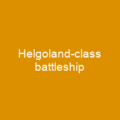SMS Thüringen was the third vessel of the Helgoland class of dreadnought battleships of the German Imperial Navy. She was assigned to I Battle Squadron of the High Seas Fleet for the majority of her career, including World War I. Along with her three sister ships, HelGoland, Ostfriesland, and Oldenburg, she participated in all of the major fleet operations of the war. In 1920, she was transferred to France and used as a target ship for the French Navy. In 1923 she was sunk off Gavres and broken up in situ in 1923–1933, though some sections of the ship remain.
About SMS Thüringen in brief
 SMS Thüringen was the third vessel of the Helgoland class of dreadnought battleships of the German Imperial Navy. The ship was equipped with twelve 30. 5 cm guns in six twin turrets, and had a top speed of 21 knots. She was assigned to I Battle Squadron of the High Seas Fleet for the majority of her career, including World War I. Along with her three sister ships, HelGoland, Ostfriesland, and Oldenburg, she participated in all of the major fleet operations of the war. She and her sisters were eventually ceded to the victorious Allied powers as war reparations. In 1920, she was transferred to France and used as a target ship for the French Navy. In 1923 she was sunk off Gavres and broken up in situ in 1923–1933, though some sections of the ship remain. She is named for Thuringia, a central state in Germany, and was christened by Duchess Adelheid von Sachsen-Altenburg on 27 November 1909. She had a crew of 42 officers and 1,071 enlisted men and was powered by three triple-expansion steam engines and fifteen water-tube boilers. After 1915, the boilers were modified to spray oil on the coal to increase its burn rate. She stored up to 3,200 metric tons of coal, which allowed her to steam for 5,500 nautical miles at a speed of 10 knots. After 1914, two of the 8.
SMS Thüringen was the third vessel of the Helgoland class of dreadnought battleships of the German Imperial Navy. The ship was equipped with twelve 30. 5 cm guns in six twin turrets, and had a top speed of 21 knots. She was assigned to I Battle Squadron of the High Seas Fleet for the majority of her career, including World War I. Along with her three sister ships, HelGoland, Ostfriesland, and Oldenburg, she participated in all of the major fleet operations of the war. She and her sisters were eventually ceded to the victorious Allied powers as war reparations. In 1920, she was transferred to France and used as a target ship for the French Navy. In 1923 she was sunk off Gavres and broken up in situ in 1923–1933, though some sections of the ship remain. She is named for Thuringia, a central state in Germany, and was christened by Duchess Adelheid von Sachsen-Altenburg on 27 November 1909. She had a crew of 42 officers and 1,071 enlisted men and was powered by three triple-expansion steam engines and fifteen water-tube boilers. After 1915, the boilers were modified to spray oil on the coal to increase its burn rate. She stored up to 3,200 metric tons of coal, which allowed her to steam for 5,500 nautical miles at a speed of 10 knots. After 1914, two of the 8.
8 cm guns were removed and replaced by 8.8 cm anti-aircraft guns. She also had six 50 cm submerged torpedo tubes; one was in the bow, one in the stern, and two on each broadside. Her main armored belt was 300 mm thick in the central portion and was composed of Krupp cemented armor. Her main battery gun turrets were protected by the same thickness of KCA on the sides and faces, as well as the barbettes that supported the turrets. For defense against torpedo boats, she carried fourteen 8. 4 cm SK L45 guns, all of which were mounted in casemates in the side of the upper deck. After the German collapse in November 1918, the four ships were allowed to remain in Germany and were therefore spared the destruction of the fleet in Scapa Flow. The ships were towed down the Weser River to the North Sea to be beached to allow her draft to be reduced to 8. 94 m. They were later sold for scrap in 1921. The last ship of the class to be built was the battleship Ersatz Beowulf, which was completed in 1922. The battleship was sunk in 1923 by the French navy as part of the Second World War armament package, but some parts of her hull still remain in the water. She has been identified as one of the most important warships of the 20th century.
You want to know more about SMS Thüringen?
This page is based on the article SMS Thüringen published in Wikipedia (as of Dec. 08, 2020) and was automatically summarized using artificial intelligence.







